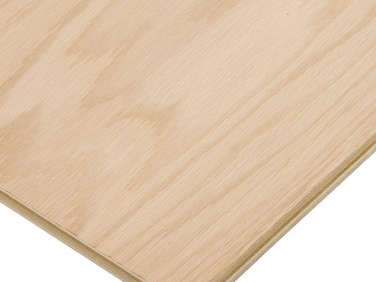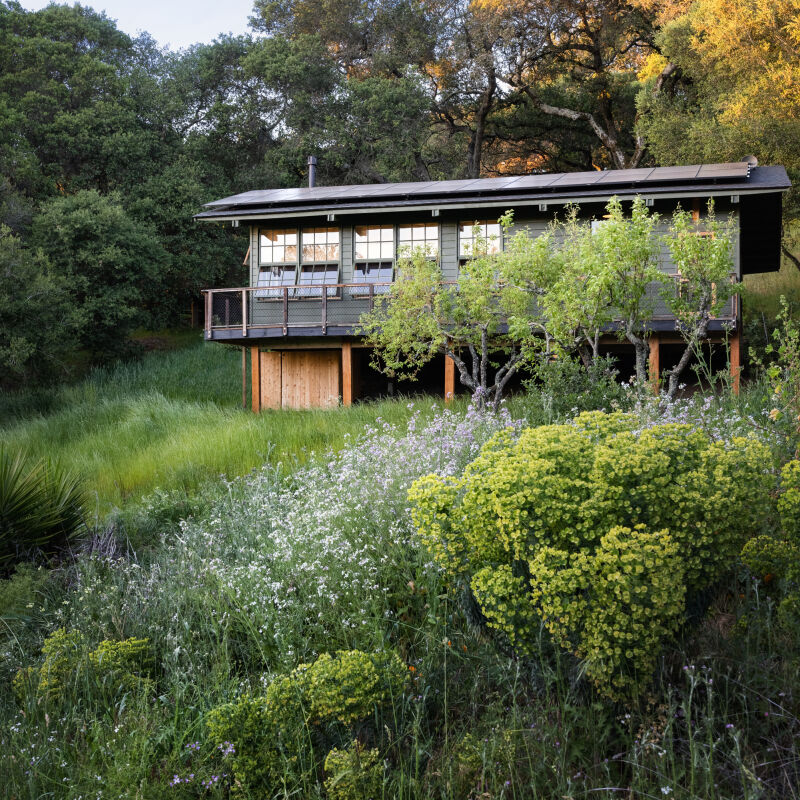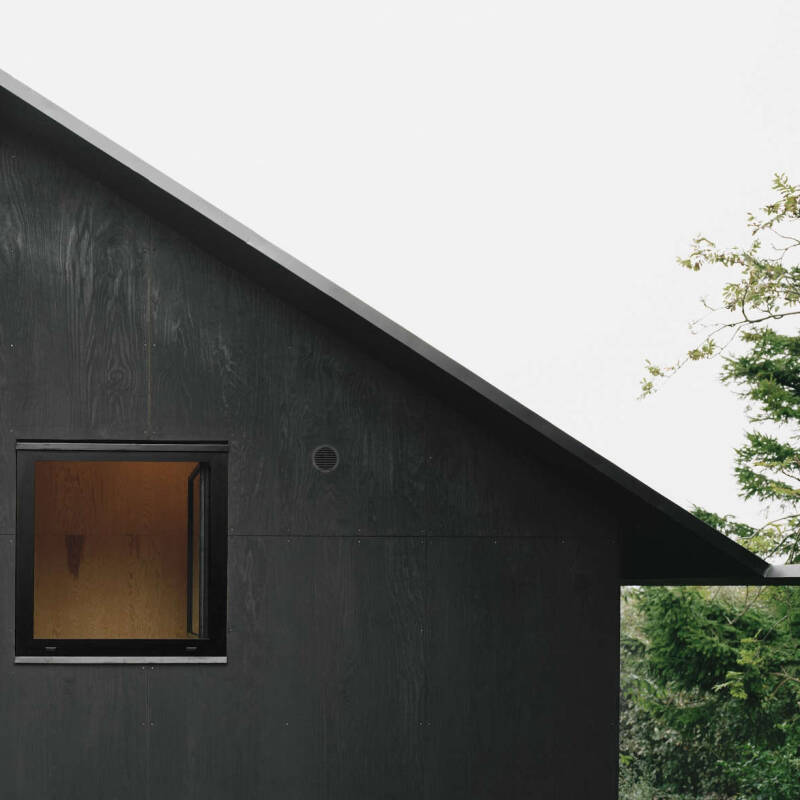Back in 1948, Popular Science described plywood, rather unappealingly, as “a layer cake of lumber and glue.” But over the decades this inexpensive engineered wood product has proved invaluable, not just for building simple structures but also for allowing interior and furniture designers alike to unleash their creativity.
While plywood has traditionally been used in unfinished areas and building sites, in recent years designers have embraced its minimalist look in finished projects. When we recently asked Swedish architect Björn Förstberg what he loves about plywood (he, with his firm Förstberg Ling, has covered entire spaces in plywood panels to stunning effect; see his Pinterest-famous House for Mother project), he waxed poetic: “It has this very organic and warm quality that makes a space feel cozy and inviting.” But what types are best to use where, and what do the letter designations mean? Are there any downsides to covering your room in plywood? Read on for our cheat sheet.

How is plywood made?
To create a sheet of plywood, a machine laminates thin layers of wood veneer together under heat and pressure. The grain of each layer is positioned at right angles to the previous layer, which gives this material its uncommon strength and durability. (Check out this Love Letter to Plywood in video form for much more detail.)
Don’t confuse plywood with other engineered woods like particleboard, MDF (medium-density fiberboard), or OSB (oriented strand board). Made of wood fibers or scraps bonded under high pressure, they’re cheaper than plywood and not as strong.

What are the different types of plywood?
Plywood comes in many grades, sizes, and thicknesses. Here’s a quick rundown.
Types
You might have heard of different kinds of plywood. A few common types are exterior plywood, which means that it has been treated to resist water and inclement weather; marine plywood, great if you’re building a boat (or something that’ll be exposed to a lot of moisture, like the inside of a bathroom); tropical plywood, usually of high quality and made overseas; and low-grade structural plywood, often used to build concrete forms on building sites. Hardwood plywood (sometimes called cabinet-grade plywood) has a softwood core, but the veneer on the face is a wood such as ash, beech, mahogany, or walnut.
Plies
Most plywood is either three-ply—that is, made of three layers of wood—or five-ply. There’s also multi-ply, which is used for heavy construction such as houses.

What are the different grades of plywood?
Plywood is generally given one of four grades that indicates its quality in terms of knots, discoloration, defects, and repaired patches. If you’ve wondered what the letters mean on your piece of plywood, it’s referring to the grade.
A Grade: A-grade plywood is premium quality plywood, with no knots and a smooth, sanded surface that’s ready to be finished.
B Grade: B grade is also sanded, but will have some knots and repairs.
C Grade: C-grade plywood is unsanded and has more “defects” than A or B grades.
D Grade: D grade goes to the least expensive plywood. Because of its markings, this might be a good type of plywood to paint over (though others might find this appealing).
Grades with two letters: Plywood panels usually carry two letter grades, for a simple reason: One letter refers to the grade of wood on the face of the sheet, the other to the wood on the back, in most cases an inferior grade. It is possible to get plywood with both sides of the same grade.
X: An “X” at the end of the designation means the panel is good for exterior use.
FSC: FSC is short for “Forest Stewardship Council,” and certifies that the plywood comes from responsibly managed forests.

What grade is best for my project?
Any hardwood plywood is suitable for fine woodworking projects such as building furniture and cabinets. Similarly, sanded softwood plywood—Grade A or B—will work for the same purposes. Those installing exposed plywood panels on interior walls, like the Förstberg Ling architects, could also choose this grade, paying careful attention to the grain. Grade C or D plywood is suited for projects such as subflooring and for structural use.
What types of wood are used to make plywood?
Softwood plywood is made of woods such as pine, cedar, Douglas fir, or spruce. The face veneer is generally a better grade of wood than the other layers; for example, hardwood plywood has a softwood core covered with a hardwood veneer like ash, mahogany, beech, or walnut.
What sizes does plywood come in?
Plywood panels come in a wide range of sizes, but are most often four feet across. The length can range from eight to 10 feet; two-by-four-foot pieces are also available for smaller projects. But be careful when measuring as the stated dimensions always fall a little short of these numbers.
Plywood also comes in many thicknesses. The most common sheet widths are ¼ inch, ½ inch, and ¾ inch, though thicker and thinner widths do exist. Again, these given dimensions are generally slightly larger than the actual sheet; for instance, ½ inch should really be labeled 15/32 inch.

What are the advantages of plywood?
“Architects have always been interested in plywood,” says Björn Förstberg, “but it may be more popular with the general public now than it’s ever been.” And for good reason, as the pluses are many: This inexpensive wood doesn’t have the shortcomings of lumber as it won’t warp, shrink, or expand. It is much used in house building but also a favorite with hobbyists and home woodworkers. And despite the fact that it’s relatively economical (more on that later), it’s incredibly strong and durable.
What are the disadvantages?
Many people consider the unfinished edges of plywood panels to be unsightly. If the edges are exposed, you may want to finish them by painting or finishing with laminate edge banding.
Another drawback is that plywood can be difficult to cut, compared to solid wood, and is prone to splintering at the edges when the face veneer is especially thin (often the case with hardwood plywoods). If you’re working on a project, be careful with sanding, as a thin veneer can suffer from vigorous sanding, as you might sand through to the next layer.
There’s also the potential for noxious gases from the adhesives used in making plywood; more on that below.

Is plywood safe?
Since plywood is treated wood, it’s wise to avoid inhaling dust when you’re cutting it. Wear a dust mask and, if possible, do your sawing outdoors. Indoor plywood made with urea-formaldehyde glue can cause health problems due to off-gassing from the wood. But recent years have brought new government standards for formaldehyde emissions, and some indoor plywood is now being made formaldehyde-free. For much more on this, see our post Remodeling 101: Is Plywood Safe?.
How much does plywood cost?
Of course, the prices vary depending on the grade, size, and thickness. To offer a few examples: ¼-inch-thick, four-by-eight-foot BC-Grade Sanded Pine Plywood sells for $19.77 per panel at Home Depot, while a 3/4-inch-thick PureBond Red Oak Plywood panel of the same size, made with a formaldehyde-free glue, sells for $54.98. Shop around for the grade, thickness, and pricing that works for you; Home Depot and other lumber and building supply companies will sell an almost endless amount of options.

Do I need to match the color and grain?
Different procedures are used to create the patterns and grains you see in the veneer on any plywood panel. Sometimes the veneer is a whole piece, taken from a single cut. At other times the sheets of veneer have been joined in a way that gives a consistent or pleasing pattern in the grain and matches the colors. Prices vary according to the method used and the resulting appearance. If the grain of the wood will be visible in your end product, that’s a good reason to choose your own plywood rather than ordering it sight unseen. But Förstberg says the grains and markings are part of the appeal: “The natural never-repeating patterns are hard to get tired of. Plywood is like a fine marble; nature does it best.”
N.B.: The featured image is from A Cost-Conscious House in Sweden That’s a Pinterest Sensation.
More on the versatility of plywood:
- 10 Favorites: The Unexpected Appeal of Plywood
- Remodeling 101: Painted Plywood—The Best Budget Wood Floor
- Architect Visit: The Practicality of Cutting-Edge Plywood
Frequently asked questions
What are the different grades of plywood?
Plywood is classified into different grades based on its appearance, quality, and intended use. Here are some frequently asked questions and their answers related to plywood grades.
What are the common plywood grades?
The common plywood grades include:
A-Grade: A high-quality grade with a smooth, sanded surface on both sides, suitable for projects where appearance is important.
B-Grade: Slightly lower in quality compared to A-Grade, with some visible imperfections such as knots and patches.
C-Grade: A lower-grade plywood with visible knots, patches, and other imperfections, suitable for projects where appearance is less important.
D-Grade: The lowest grade of plywood, often used for structural purposes where appearance is not a concern.
What are the pros and cons of A-Grade plywood?
Pros of A-Grade plywood:
Smooth, sanded surface on both sides
Minimal visible imperfections
Suitable for projects where appearance is important, such as cabinetry or furniture making
Cons of A-Grade plywood:
More expensive compared to lower-grade options
May not be necessary for projects where appearance is not a priority
What are the pros and cons of B-Grade plywood?
Pros of B-Grade plywood:
Lower cost compared to A-Grade plywood
Acceptable quality for many applications
May still have a smooth surface on one side
Cons of B-Grade plywood:
Visible imperfections, such as knots and patches, may be present
May require additional finishing or sanding for a smoother appearance
What are the pros and cons of C-Grade plywood?
Pros of C-Grade plywood:
Lower cost compared to higher-grade options
Acceptable for projects where appearance is less important, such as subflooring or sheathing
Provides structural strength and stability
Cons of C-Grade plywood:
Visible knots, patches, and other imperfections
Requires additional finishing or covering if appearance is a concern
What are the pros and cons of D-Grade plywood?
Pros of D-Grade plywood:
Most affordable option
Provides structural stability and strength
Suitable for projects where appearance is not a consideration, such as underlayment or temporary structures
Cons of D-Grade plywood:
Visible knots, patches, and other imperfections
Requires additional finishing or covering if appearance is important
Can plywood grades be used interchangeably?
Plywood grades are designed to serve specific purposes, and it is generally not recommended to use them interchangeably. Each grade has its own characteristics, strengths, and limitations. Using a lower-grade plywood in a project that requires higher-grade plywood may result in compromised aesthetics or performance. It's important to consider the intended use and appearance requirements of your project and choose the appropriate plywood grade accordingly.






